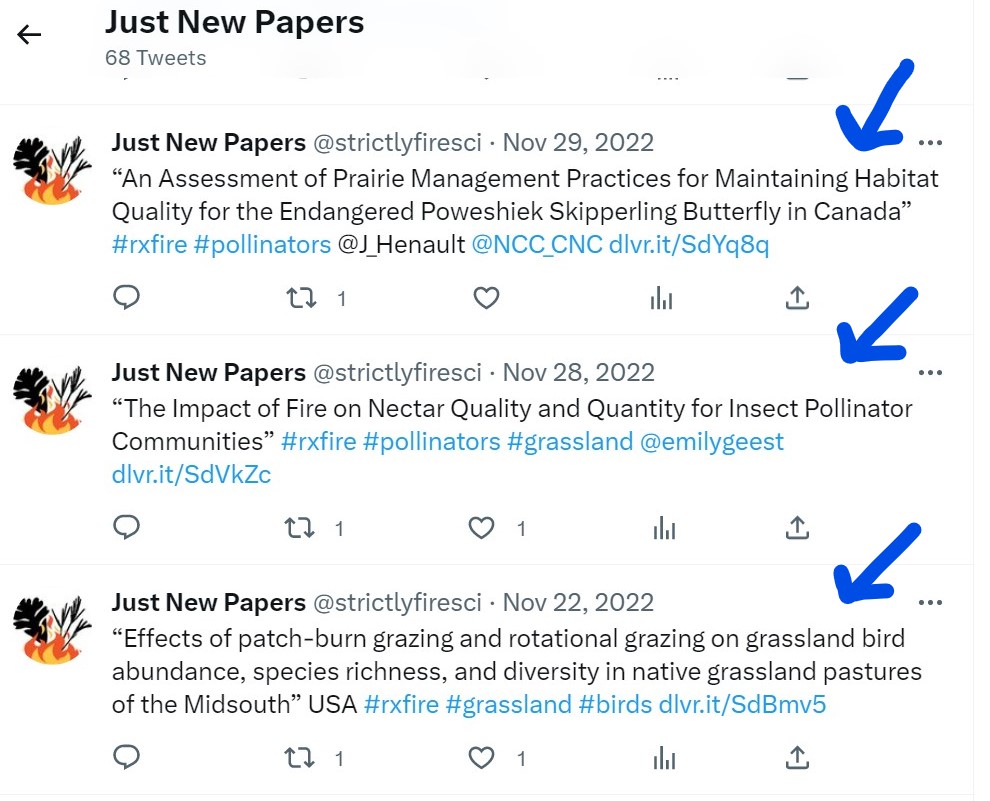About the "New Science Blog" @prairiefiresci
 Friday, January 27, 2023 at 10:15AM
Friday, January 27, 2023 at 10:15AM This description has been updated from the previous version published in December 2022.
The "New Science Blog" exists to increase the rate at which relevant science is shared with practitioners and researchers in the Upper Midwest.
Curating the blog:
The blog is curated to meet our major goal of sharing applied science with practitioners. The main goal is to have a place to easily share the latest publications. In between new publications, we are also sharing articles published between 2019-2022.
Papers shared via the blog are selected for their potential relevance to fire practitioners, land managers, ecologists, researchers, and policy makers in the region.
Your feedback about whether we were too narrow or too broad with our first selections will help us modify how we determine which papers to share.
How we find new publications:
The primary way we find new publications is through Google Scholar. Google Scholar alerts notify us when new fire science publications have been published for the tallgrass prairie and oak savanna ecosystems; for example, Google Scholar alerts notify us of papers that include both the phrase "tallgrass prairie" and "fire."
Google Scholar has tools you can use to easily create your own advanced searches and get updates in your inbox. Use the "Create alert" icon at the bottom of the left-hand menu on Google Scholar (scholar.google.com).
Other common ways we hear about new publications are through pre-publication presentations at conferences, updates on Twitter, and directly from authors.
The types of publications we tend to share:
Readers can expect to see an emphasis on papers that compare restoration and management techniques that incorporate prescribed fire (for example, research published in Restoration Ecology, Ecological Restoration, Fire Ecology, Conservation Biology, Ecosphere). Studies of fire effects on taxa and other natural history papers also provide valuable information to land stewards and wildlife biologists (journals such as American Midland Naturalist [RIP], Natural Areas Journal, and Biodiversity Conservation).
We will also share papers that provide examples of fire ecology research methods that can be applied to management challenges in the TPOS region even if the study was not conducted here.
Some or our readers have interest in papers that share interesting perspectives on fire ecology, wildfire, and prescribed fire, whether or not the information can be directly applied. You can expect to see about 5-10 percent of posts here sharing new peer-reviewed papers that address national policy, issues that affect public opinion about prescribed fire (like smoke), and fire science that is otherwise nationally or internationally notable.
There are multiple options to follow the New Science Blog:
There are a couple of ways to access the New Science Blog.
The blog is linked to the "Just New Papers" Twitter account (@strictlyfiresci), which posts automatically as this blog is updated.
An alternative way is to subscribe directly to this blog using RSS - http://www.tposfirescience.org/new-science/rss.xml
The third way, and the simplest for those who aren't interested in Twitter, is to watch for research round ups in the TPOS newsletter (join here).
Blog Article Titles
When new blog articles are posted, a social media management service posts a link to the article on @strictlyfiresci. The article title becomes the text of the tweet, along with a link back here to the article. To help boost visibility, blog article titles include the science publication's title as well as relevant hashtags (topics) and Twitter handles (depending on the article, the journal, one more authors on the publication, and the research funders may have accountes; we also often tag other outreach organizations).


